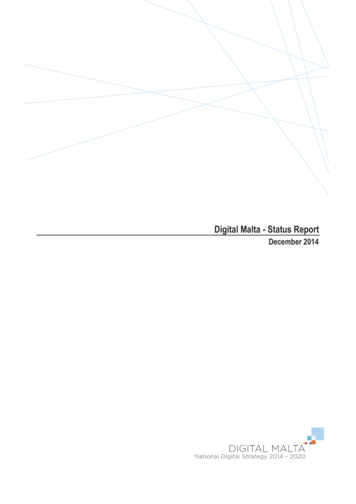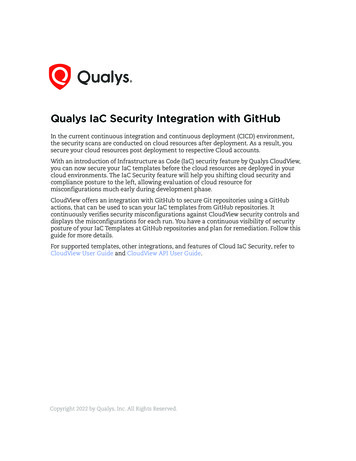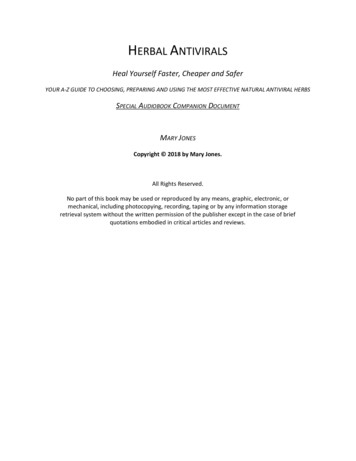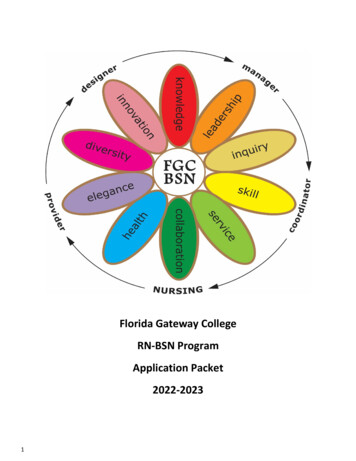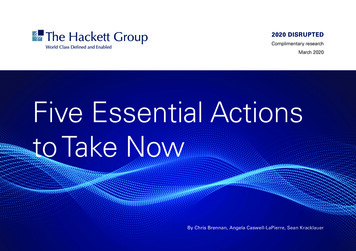
Transcription
2020 DISRUPTEDComplimentary researchMarch 2020Five Essential Actionsto Take NowBy Chris Brennan, Angela Caswell-LaPierre, Sean Kracklauer
The global coronavirus pandemic has produced a humanitarian crisisunlike anything we have ever seen, with sudden and dramatic disruptionacross all industries and markets. One thing is clear: Companiesmust respond effectively moment to moment as they receive insightswith each news cycle. They must also be prepared to act swiftly andaggressively to counter each disruption and protect their most valuableassets, while anticipating the next turns and moves ahead.The five essential actions that follow can yield a significant, positiveimpact in the near term. These actions can also be catalysts formeaningful performance improvement in the longer term as crucial firststeps to close the performance gap. In fact, top-performing companiesoperate at 57% less cost, which, for a 10 billion organization, equatesto approximately 200 million in cost savings from general andadministrative (G&A) efficiency alone. 2020 The Hackett Group, Inc. All Rights Reserved.The Hackett Group I 2020 Disrupted I 2
1Protect your employees and keep them informed and engaged.WHAT YOU NEED TO DO NOW:HERE IS HOW:First and foremost, companiesmust prioritize the health and safetyof their workforce throughout thepandemic. Organizations must alsoprovide employees with the toolsand support they need to performtheir jobs productively amid rapidlyevolving directives. Communicationthat is timely, transparent and twoway is essential to keep employeesinformed and sustain their connectionto the organization. Lastly, this periodof virtual work presents a uniqueopportunity for employees to useself-directed learning tools to furtherdevelop their skills. P rovide employees with the resources and systems support they need to workfrom home. Utilize online collaboration tools to maintain a sense of communityand boost productivity. Communicate clear, job-specific guidelines to ensure employees understandwhat is expected of them to meet customer needs and sustain operations. Make employees feel supported and valued by coaching them through challengingsituations and recognizing extraordinary efforts. Encourage employees to use up to 40 hours of time to focus on learning anddevelopment. Direct managers to conduct daily check-ins with employees through team calls,virtual collaboration site interaction and one-on-one or email/text/chat conversations. Create a weekly enterprise workforce pulse survey with five areas to assess:1. Sense of personal well-being/safety2. Level of connectedness with company3. Level of engagement with their team/manager4. Satisfaction with virtual enablement tools5. Sense of value contribution Use formal and informal feedback mechanisms in the near term to gauge employeesentiment and surface issues/barriers that need to be addressed quickly. Engage human resources to conduct workforce-related scenario planning and buildcontingency plans to ensure preparedness amid novel and uncertain circumstances. 2020 The Hackett Group, Inc. All Rights Reserved.The Hackett Group I 2020 Disrupted I 3
2Defend your financials.WHAT YOU NEED TO DO NOW:HERE IS HOW:To protect current liquidity, revenuesand earnings and mitigate impacts onstock price, bond and debt covenants,companies must accelerate forecastingfrequency and provide executiveswith visibility to daily/weekly versusmonthly/quarterly insight. P repare for an environment of tighter credit and investigate ways to secure additionalfunding sources at a reasonable cost. Stress test your cash position, inventory levels, and short- and long-term liabilities toidentify areas of significant financial exposure. Update models as new information arises. T ake immediate and aggressive cost-out actions to reduce expenses (e.g., traveland expenses, hiring freezes, operating expense/capital expense diligence, andconsolidation of work). Evaluate your labor costs and current workforce management processes and practicesfor opportunities to reduce cost. In most firms, this is an orphan category of processesthat no single leader owns. For example, we have seen two companies identify savingsopportunities of 200K and 500K per week, respectively, in the form of labor leakageand unscheduled overtime. Optimizing worker hours will enable them to keep moreemployees at work and buffer the expense of other employees who must self-quarantine. Utilize cross-functional crisis teams to execute mitigation strategies in real time as newrisks are identified. Focus on improvements that deliver information faster and increase executive visibilityinto demand trends, daily sales activity, supplier risk indicators and production data. Accelerate communication with key stakeholders, including the board, vendorsand investors.Decision-making under conditionsof high uncertainty requires takingcalculated risks predicated onimperfect and ever-changing data.This will require frequent scenarioplanning and simulations to testmultiple planning hypotheses,making optimum use of the bestinformation available. 2020 The Hackett Group, Inc. All Rights Reserved.The Hackett Group I 2020 Disrupted I 4
3Safeguard your supply chain.WHAT YOU NEED TO DO NOW:HERE IS HOW:This environment poses a uniqueneed to manage both demand shocksand supply disruptions. To counterdemand shock, companies mustproactively identify and analyze anarray of scenarios and use that analysisto prioritize and plan their response.Supply disruptions also require ananalysis of scenarios to identify theimbalances between supply anddemand by product and geography.Companies will also need to prioritizechannels and customers, andthen apply that prioritizationto execute solutions. D evelop a rapid demand shock response plan: How will we implement leading options?How do we sequence key activities? Analyze supply and demand scenarios to project shortages. Understand the percentageof suppliers in high-risk regions. Prioritize options and define allocation rules. Monitor the following key crisis indicators daily:1. Demand impacts: percentage of change in unit volume sold; percentage of changein net revenue; average unit selling price2. Supply impacts: percentage of change in units produced; percentage of change indays of inventory on hand; percentage of change in available unit capacity Develop a supply disruption rapid response plan: Which resources need to be mobilizedto closely manage the situation? How will we make decisions and track those centrally? 2020 The Hackett Group, Inc. All Rights Reserved.The Hackett Group I 2020 Disrupted I 5
4Preserve your cash.WHAT YOU NEED TO DO NOW:HERE IS HOW:Companies may find that to deal withdisruption they need to inject liquidityinto the end-to-end supply chainthrough customer and supplierterms management and/or strategicinventory builds. C reate a cash task force to monitor key cash metrics weekly, if not daily. Define weekly cash collection targets. Replan all customer touchpoints by value,not volume. Tighten up accounts receivables processes by putting in place (or strengthening)proactive collections processes, minimizing errors that can delay payments, andoptimizing billing frequency. Make sure that credit risk processes are robust and up to date, and incorporatelast-minute information given the current fluidity. Monitor established customersfor payment behavior changes. Introduce liquidity mechanisms, such as financing solutions or payment termssupport for smaller customers and suppliers, into the supply chain. Monitor daily demand fluctuations and supply limitations closely to ensure that cashis not invested in the wrong inventory. Cascade key metrics and the dollar value of each day of working capital metrics(days sales outstanding/days payables outstanding/days inventory outstanding)across all operational decision-makers to raise cash awareness in daily activities. Tighten up end-to-end procure-to-pay processes, especially around invoice timingand payment terms operations to minimize leakage. Review stocking parameters and consider temporarily streamlining the productportfolio to allow buffering of strategic stocks. Identify alternate supply sources or substitution opportunities for stock keeping units at risk.Accessing sources of excess cashwithin current working capitalmanagement practices will mitigatethe impact and help organizationssupport their supply chains inweathering the storm. US companieshad 1.3 trillion tied up in excessworking capital during 2019 – anincrease over the previous year. 2020 The Hackett Group, Inc. All Rights Reserved.The Hackett Group I 2020 Disrupted I 6
5Fortify your infrastructure.WHAT YOU NEED TO DO NOW:While the focus understandably hasbeen on short-term business continuity,it is important to consider the demandson the information technology (IT)function over the coming months andreprioritize effort and investmentsquickly. Focus should be on fortifyingthe infrastructure to sustain virtualwork and collaboration over a period oftime – possibly indefinitely as operatingmodels may shift to new, postpandemic norms. Agility will be key: ITmust monitor connectivity, throughputand productivity, and make adjustmentsrapidly if needed. 2020 The Hackett Group, Inc. All Rights Reserved.That said, recognize that this is also not the time to compromise strategic IT initiatives.As the largest G&A spend category, IT is a ripe target for cost cutting. However, doingso without a clear and thoughtful action plan and value assessment carries a high risk ofjeopardizing long-term competitiveness and the ability for the business to recover quickly.HERE IS HOW: R eview and segment the IT demand portfolio by critical must-do’s and reprioritizeprojects based on capacity and level of investment. Eliminate or defer lower-priorityinitiatives. Assess and strengthen security protocols in light of the number of employee devicescurrently used to access services. Educate employees about security guidelines forsystems and collaboration tools to prevent hacking and other intrusions. Make sure your IT operating model can sustain support for the spike in virtualwork and collaboration over time. This may require additional remote IT support andsecurity capacity. Ensure you have sufficient collaboration tools for enabling productive, virtual work andtouchpoints throughout the day. Work with service providers and vendors to deploycollaborative tools, such as virtual whiteboards, that fill gaps in current services.The Hackett Group I 2020 Disrupted I 7
About the authorsCHRIS BRENNANANGELA CASWELL-LAPIERRESEAN KRACKLAUERExecutive Vice PresidentPrincipal, Strategy and BusinessTransformationPrincipal, Strategy and BusinessTransformationChris Brennan has morethan 20 years of experienceassisting executives atFortune 1000 companies,focusing on large-scaletransformational improvements within thefinance, human resource and supply chainfunctions. His expertise covers a wide rangeof industries and business sectors, includingretail, manufacturing, transportation, mediaand entertainment, consumer packagedgoods, food and beverage, and financialservices. Key clients include FedEx, Ryder,Procter & Gamble, Pepsico, Target Stores,Tyson Foods, Yum Brands, 7-Eleven Stores,Fannie Mae, Fidelity Investments, StanleyCorporation, Wyeth Pharmaceuticals, RioTinto, Terex, ExxonMobil, Xerox, GeneralMills and General Electric. Prior to joiningThe Hackett Group, Chris was a partner atKPMG Consulting.Angela Caswell-LaPierrehas over 20 years ofindustry and consultingexperience. She hasparticular expertise inleading and integrating global businessservices operations, global financetransformation projects, enterprisewidetransformation management offices, globalSAP enterprise resource planning systemimplementations, process reengineering,change management, and enterprise costreduction programs. Before joining TheHackett Group, Angela held senior leadershippositions at Johnson & Johnson, Pfizer andInterpublic Group, and has directed a numberof engagements for Fortune 500 companiesundergoing transformational change.Over the past 20 years,Sean Kracklauer has advisedGlobal 1000 businesseson strategy, organizationalstructure and processredesign. He has worked extensively in financestrategy, business performance management,planning and budgeting, financial reportingcompliance, and functional design for businessintelligence systems. His fields of expertiseinclude leading large-scale cross-functionalprojects to improve the effectiveness andefficiency of general and administrativeservice delivery by identifying the optimalstrategy, structure, sourcing and enablingtechnologies to achieve business objectives.Sean has served clients, with revenue from 5 million to over 100 billion, in the financialservices, technology, pharmaceutical,telecommunications, energy, health care,retailing, consumer packaged goods, software,broadcasting and manufacturing sectors. 2020 The Hackett Group, Inc. All Rights Reserved.The Hackett Group I 2020 Disrupted I 8
This is a crisis in multiple respects, so it is helpful to adopt the principles and characteristics of a crisis response: a war room thatintegrates multiple teams working parallel with key leaders who are using a key crisis indicator dashboard to govern responses.Without that mindset, response and recovery will take longer.Act now to protect your employees,financials and futureBacked by our unparalleled benchmarking data and best practices repository, as well as experience across the full transformation lifecycle, The Hackett Group can help you identify areas of cost reduction, increase organizational agility, and make transformative changesto your operating model to create a more resilient organization. We are armed with know-how, tools and experience to support thesegoals – and ready to assist.To learn more, please contact us at 1 866 614 6901 (US) or 44 20 7398 9100 (UK), or visit us online at tgroup.com/linkedinThe Hackett Group1000 Abernathy Road NESuite 1400Atlanta, GA 30328T. 1 770 225 3600T. 1 866 614 6901 (toll-free)W. www.thehackettgroup.comLondonCannon Green27 Bush LaneLondon, EC4R 0AN, UKT. 44 20 7398 9100
Tinto, Terex, ExxonMobil, Xerox, General Mills and General Electric. Prior to joining The Hackett Group, Chris was a partner at KPMG Consulting. CHRIS BRENNAN Executive Vice President Angela Caswell-LaPierre has over 20 years of industry and consulting experience. She has particular expertise in leading and integrating global business

